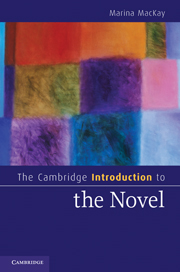Book contents
- Frontmatter
- Contents
- Acknowledgments
- About this book
- Chapter 1 Why the novel matters
- Miguel de Cervantes, Don Quixote (1605, 1615)
- Chapter 2 Origins of the novel
- Laurence Sterne, The Life and Opinions of Tristram Shandy, Gentleman (1759–67)
- Chapter 3 Narrating the novel
- James Hogg, The Private Memoirs and Confessions of a Justified Sinner (1824)
- Chapter 4 Character and the novel
- Nathaniel Hawthorne, The Scarlet Letter (1850)
- Chapter 5 Plotting the novel
- Gustave Flaubert, Madame Bovary (1857)
- Chapter 6 Setting the novel
- Charles Dickens, Bleak House (1853)
- Chapter 7 Time and history
- Virginia Woolf, To the Lighthouse (1927)
- Chapter 8 Genre and subgenre
- Graham Greene, The Ministry of Fear (1943)
- Chapter 9 Novel and anti-novel
- Thomas Pynchon, The Crying of Lot 49 (1966)
- Chapter 10 Novel, nation, community
- Salman Rushdie, Midnight's Children (1981)
- Chapter 11 Concluding
- Notes
- Glossary
- Further reading
- Index
- Cambridge Cultural Social Studies
Charles Dickens, Bleak House (1853)
Published online by Cambridge University Press: 05 June 2012
- Frontmatter
- Contents
- Acknowledgments
- About this book
- Chapter 1 Why the novel matters
- Miguel de Cervantes, Don Quixote (1605, 1615)
- Chapter 2 Origins of the novel
- Laurence Sterne, The Life and Opinions of Tristram Shandy, Gentleman (1759–67)
- Chapter 3 Narrating the novel
- James Hogg, The Private Memoirs and Confessions of a Justified Sinner (1824)
- Chapter 4 Character and the novel
- Nathaniel Hawthorne, The Scarlet Letter (1850)
- Chapter 5 Plotting the novel
- Gustave Flaubert, Madame Bovary (1857)
- Chapter 6 Setting the novel
- Charles Dickens, Bleak House (1853)
- Chapter 7 Time and history
- Virginia Woolf, To the Lighthouse (1927)
- Chapter 8 Genre and subgenre
- Graham Greene, The Ministry of Fear (1943)
- Chapter 9 Novel and anti-novel
- Thomas Pynchon, The Crying of Lot 49 (1966)
- Chapter 10 Novel, nation, community
- Salman Rushdie, Midnight's Children (1981)
- Chapter 11 Concluding
- Notes
- Glossary
- Further reading
- Index
- Cambridge Cultural Social Studies
Summary
Many novels are named after the house where the action takes place, and it is often said of novels like The Castle of Otranto, Wuthering Heights, and The House of the Seven Gables that the novel's main character is the house itself, the setting the principal agent of the narrative. But if you look at Bleak House in this light, the first thing you notice is how small a part is played by the two houses named “Bleak House.” The first Bleak House is John Jarndyce's blandly serene Hertfordshire home where Esther Summerson lives with the wards of Chancery, Ada and Richard; the second is the equally peaceful Yorkshire cottage Jarndyce prepares for Esther and her husband Allan Woodcourt. Neither house appears in the novel for any length of time, and, of all the novel's many architectural spaces, they are the least bleak of all, and the ones of which least can be said. In keeping with the novel's interest in hypocrisy and secrecy, the truly bleak houses of Dickens's novel go by other names.
All the possible titles Dickens considered and rejected before he settled on “Bleak House” made some reference to the abject London slum Tom-all-Alone's, where Jo the crossing sweeper spends most of his miserable life. The slum is a contested legacy long since caught up in the Court of Chancery, and, in view of Dickens's concern with the casualties of the English establishment for which Chancery is made to stand, it makes sense that Dickens might have wanted to emphasize the symbolic significance of Tom-all-Alone's by making it the title of his book.
- Type
- Chapter
- Information
- The Cambridge Introduction to the Novel , pp. 115 - 118Publisher: Cambridge University PressPrint publication year: 2010

